Van Gogh Museum Journal 1999
(1999)– [tijdschrift] Van Gogh Museum Journal–
[pagina 84]
| |
[19th-century Studies]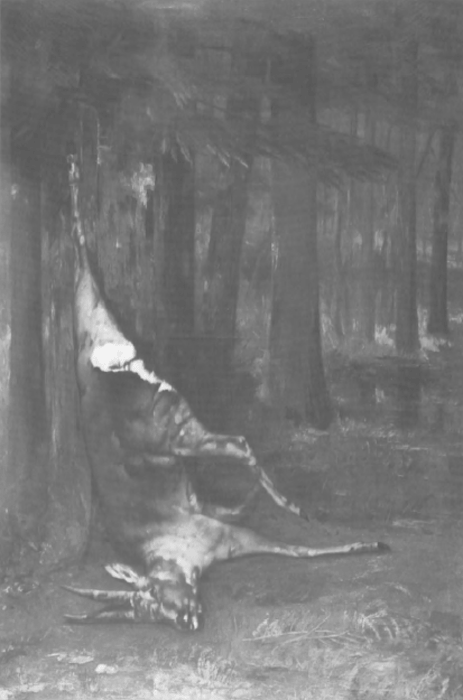 fig. 1
Gustave Courbet, Hanging roe deer, 1858, The Hague, Museum Mesdag | |
[pagina 85]
| |
The painter as prey: Courbet's Hanging roe deer in the Museum Mesdag
| |
[pagina 86]
| |
First and foremost, Courbet's hunting scenes were based on his own tangible experiences: the artist was a fanatical hunter. He regularly ventured into the Jura forest near his birthplace with his hunting comrades, not only in his youth, but whenever he visited the region. Hunting gave Courbet a great deal of pleasure, and he especially delighted in physical exertion in the land of his roots.Ga naar voetnoot3 He frequently wrote about these hunting parties in letters to his friends, and they contributed to the image of the virile, all-rounder he liked to project. However, his identification with the figure of the hunter went still further: in this ideal role he could personify his own rejection of convention. To him, he was a ‘man with an independent spirit’; he was free. Courbet expressed his intensely romantic feelings for nature in his statements regarding the hunter: ‘he is a wounded soul, with a heart whose languor is fostered by the vague and the melancholy of the forests.’Ga naar voetnoot4 For Courbet this freedom and independence was closely associated with a challenge to authority. Although it was illegal, he repeatedly went hunting in winter and he was once even arrested by the gendarmerie and subjected to a large fine.Ga naar voetnoot5 Many of his scenes, such as the Exhausted doe (fig. 3), show hunters in the snow. Based on this painting, the critic Maxime de Camp felt certain that the painter had never hunted in his life; after all, hunting in the snow had been outlawed since 3 May 1844. He also thought one could easily see that the scene was ‘pure fantasy.’Ga naar voetnoot6 By claiming that the paintings were not realistic, the critic was attempting to deliver a severe blow to Courbet's art. This raises the question of how realistic these paintings actually are and, by implication, how they relate to the artist's own realist aims at this time, around 1860. Courbet placed himself at the heart of The quarry (fig. 2), standing model for the shady-looking hunter leaning with folded arms and downcast eyes against a tree. Although he is the central feature of the composition, he performs the part with a decidedly low profile. It is the figures surrounding him that demand attention: the roe deer; the hesitant hounds as they approach; the minute horn blower with his red vest. Each has been painted with a great deal of emphasis, both in terms of colour and brushwork. The background of woods is rendered schematically, mainly using a palette knife. Despite our admiration for the powerful execution of each individual element, the whole produces a slight feeling of alienation.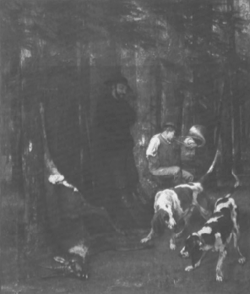 fig. 2
Gustave Courbet, The quarry: deer hunt in the forests of the Great Jura, 1857, Boston, Museum of Fine Arts It is as if each of these parts has been conceived independently; scale and light seem not so much to follow an overall plan as to have been formulated as the need arose. This lack of perspective and correct proportions was a constant theme in the criticism of Courbet's work. Théophile Gautier praised the artist's ‘exécution,’ but spoke of his insufficient ‘feeling for proportion and ground distances’;Ga naar voetnoot7 Edmond About wrote of his ‘maladresses de perspective.’Ga naar voetnoot8 Only the painter-critic Zacharie Astruc, the defender of Manet, was able to appreciate these presumed ineptitudes. He argued astutely that ‘no superior human endeavour’ could exist without such ‘imperfections.’Ga naar voetnoot9 (Horace: ‘[...] sometimes even excellent Homer nods.’) However, it never occurred to any of these critics that Courbet might not have been at all interested in linking his figures and groups ‘properly.’ After all, every graceful arrangement presumes the artist's intervention and is thus an unavoidable form of contrivance. This rejection of artifice had a social and political significance. When one of Courbet's pupils expressed a desire to depict a beautiful view, the master roared with | |
[pagina 87]
| |
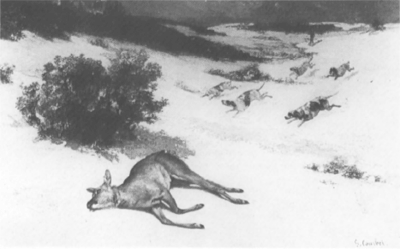 fig. 3
Gustave Courbet, Exhausted doe in the snow (Jura), 1857, New York, private collection laughter. The student, he said, reminded him of ‘that poor Baudelaire,’ who had once wanted to show him a beautiful sunset at an exquisite location: ‘How bourgeois! What are views exactly? Do they really exist?’Ga naar voetnoot10 The innocence of an event as it is visually perceived is lost in the selection of picturesque elements. It becomes a theatrical arrangement, constructed by the painter to oblige the spectator, but which nonetheless seeks to give the impression that the scene took place the way it is depicted and no other. Just as using the palette knife to spread colour leaves much to chance, and therefore constantly reminds the viewer that what he is looking at is paint, collage can be used to signal that what is shown is inevitably an arrangement - albeit one that is as accidental as possible. The configured elements are indeed derived from reality, but the whole has been subjected to the will of the artist. An awkward composition, in any case, can give the illusion that the design is not premeditated. In his famous open letter ‘Aux jeunes artistes de Paris,’ published in the Journal de Dimanche, Courbet argued that ‘painting is essentially a concrete art and consists only in the representation of real and existing things. It is an entirely physical language that uses for words all visible objects; an abstract object, not visible, nonexistent, is not of the domain | |
[pagina 88]
| |
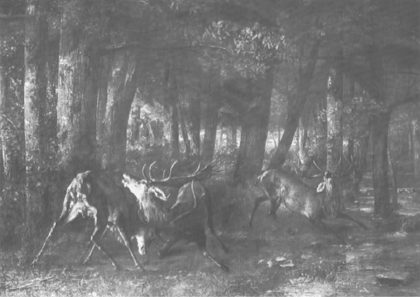 fig. 4
Gustave Courbet, Spring rutting: the battle of the stags, 1861, Paris, Musée d'Orsay of painting. Imagination in art consists in knowing how to find the most complete expression of an existing thing, but never in conjecturing or creating the thing itself.’Ga naar voetnoot11 This notion can, of course, be well applied to landscape, still lifes and portraits. However, when it comes to figural works, it is very difficult to avoid composition and to rein in the imagination. Courbet's large figure pieces from the 1850s, such as The stonebreakers (destroyed), The painter's studio (Paris, Musée d'Orsay) and A burial at Ornans (Paris, Musée d'Orsay), also consist of juxtapositions of figures that lack dramatic concentration. Although these works were painted in the format of history paintings, the artist avoided all the visual rhetoric usually associated with the genre - composition, choice of moment, expressive body language and revealing facial expression. In terms of this avoidance of the theatrical, Courbet's hunting scenes are in some respects an exception. As if sensing that something else was at stake in these hunt pieces than in his earlier large canvases, Courbet often emphasised the trouble he had taken in trying to make these monumental works as realistic as possible. His Battle of the stags (fig. 4), for example, was based on rutting scenes he had seen a few years earlier in Wiesbaden and Bad Homburg. ‘I am completely sure of their movements,’ he wrote and hastened to explain how strong these animals were, even though no muscles show on the surface. This was the terrain he regarded as his own, ‘a fact that belongs to me,’ and the paintings were to form a series intended for hunters. He added confidently that these pictures brought something entirely new to the history of art: ‘they know no equal, either in tradition, or in modern times.’ These dramatic tableaux were completely realistic because ‘they [did] not contain a grain of idealism.’ On the contrary, they stood out through their observed precision: ‘in their quality they are as precise as a mathematical sum.’Ga naar voetnoot12 However, deer are not inclined to pose in their natural habitat in the positions desired by the painter. For the final rendering of the Battle of the stags, executed in Frankfurt, he had to turn to two stuffed | |
[pagina 89]
| |
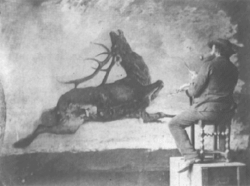 fig. 5
Photo by E. Carjat showing Courbet at work, from M. Fried, Courbet's Realism, Chicago & London 1990, fig. 70 deer. His admiration for the taxidermist was considerable: ‘this is nature caught in the act.’Ga naar voetnoot13 Because their performance was entirely natural, these deer were ideal actors for Courbet.Ga naar voetnoot14 They embodied everything that made history painting exciting - action, passion, violence - without the artist having to invent anything. The theatricality of history painting - a composition arranged to affect the viewer in a certain way - was thus avoided. The picture was simply a combination of animals and landscape, albeit that the German deer are situated in a spring forest in the Jura. But even here Courbet was able to appeal to realism, stating that ‘the event in the painting determines the time of year.’Ga naar voetnoot15 This reveals something of his working method. The animals were done first and the landscape added later: the deer in the Battle of the stags were painted in Frankfurt and the landscape after the artist's return to France.Ga naar voetnoot16 Further evidence is supplied by a photograph (fig. 5) of Courbet at work on the deer at the centre of L'hallali, which shows that the desperate animal was initially painted against a neutral background; there is no evidence of a compositional sketch or plan. The entourage, hounds, hunters and landscape were carried out afterwards. This cumulative method of working accounts for the lack of composition so criticised by Courbet's contemporaries. The effect is even more accentuated in The quarry (fig. 2), where the artist painted the various parts on five separate canvases, which were subsequently sewn together. The small overlaps between the whipper-in and the hounds are designed to suggest unity, but each of the elements has been painted and lit in a different way. The sections showing the master and the dogs are executed in thick impasto, using bright colours and sharp modelling, while the deer and the hunter are depicted in much softer tones and tempered light. Bruce K. MacDonald has reconstructed the sequence in which the work was made: Courbet first did a study of the hanging deer, to which he then added the hunter; he then supplemented this with two additional canvases, one showing the horn blower, the other the hounds.Ga naar voetnoot17 Finally, a thin strip of landscape was appended on the right. This was the state of the painting at the Salon of 1857, as we can see from a lithographic reproduction that appeared in L'Artiste on 18 July 1858 (fig. 6). It will come as no surprise that Jules Castagnary, who immediately became a great supporter of Courbet's, was full of praise for the painting in his Salon review, although there was one aspect his critique did not spare; he felt there was a compositional error: ‘the | |
[pagina 90]
| |
 fig. 6
Lithograph after The quarry, from L'Artiste (18 July 1858) painting stops too abruptly at the top.’Ga naar voetnoot18 Perhaps in response to this criticism, or at the request of his dealer, Jules Luquet - who hoped to increase his chances of selling the painting - an extra piece of canvas was added to the upper edge in 1864, providing the figures with more air.Ga naar voetnoot19
At what point do the histories of the painting in the Mesdag Museum (fig. 1) and The quarry coincide, and what is the relationship between the two paintings? It is evident that the Mesdag picture shows the same deer, although the landscape is slightly different. Is it thus a preparatory study, as is commonly accepted? This seems an obvious conclusion, since the Hanging roe deer shows just part of the composition of The quarry. Three things, however, make their association less straightforward than it initially appears. In the first place, the Mesdag painting is dated ‘58,’ at least one year later than The quarry. Then there is the question of scale: assuming that the canvas on which The quarry was begun originally showed only the deer, with the standing hunter being added later, not only would it have been smaller than that of Hanging roe deer, the proportions of the deer itself would have been smaller as well.Ga naar voetnoot20 It is, however, highly unlikely that a preparatory study would be larger than the final painting. In addition, the rendering of the fur in the Mesdag painting is considerably more subtle, suggesting that it is, in fact, an improved version of the Salon picture. It was the exceptional refinement of the painting that struck Paul Mantz when he saw it at an exhibition in Lyon in 1861: ‘For as long as vigorous brushwork and sureness of touch are valued in France, the Roe deer will be appreciated.’ He, too, saw a connection between the painting and The quarry: he thought it was the ‘original study,’ but it also seemed to him that it might be a ‘fragment of the painting [...] that hung at the Salon of 1857.’Ga naar voetnoot21 The discrepancy between the later dating and its possible function as a preparatory study was spuriously solved by Robert Fernier, who read the date at the lower right as ‘55’; Hélène Toussaint interpreted the date correctly, and identified the Mesdag painting as an indepen- | |
[pagina 91]
| |
dent work of art. Like Mantz, she was unable to establish a more precise relationship with The quarry other than to say that it was perhaps a première pensée, or a répétition. Bearing in mind Courbet's occasional carelessness with dating, she decided to stick with the first interpretation.Ga naar voetnoot22 However, such a stopgap measure is unnecessary when one considers Courbet's working method. Courbet lived in Frankfurt from the beginning of August 1858, and it was here that one of his pupils, Otto Scholderer, saw the Hanging roe deer as a completed picture: ‘A deer hanging from a tree; the landscape is mirrored in a small stream.’Ga naar voetnoot23 It seems plausible that the artist finished and dated the painting in Frankfurt. In the first place, there is a major difference in the way the animal and the background have been painted. It looks as though the deer was attentively painted from nature, literally a nature morte, while the background has been applied with virtuoso strokes of the palette knife, one of the artist's technical specialities. In addition, the border between the animal and the background is marked by a dark outline. The following chronology thus seems most likely: the roe deer in the Mesdag picture was painted from life in 1857 or shortly before, perhaps after an animal provided by a butcher in the Rue Montorgueil, where Courbet frequently acquired game for his paintings.Ga naar voetnoot24 A little later he repeated the painting in a slightly smaller format, to which he subsequently appended the various fragments, resulting in the Salon picture of 1857, The quarry. He then took the Hanging roe deer with him to Frankfurt in 1858, where he filled in the background and dated it. When he decided to add more space to The quarry, he took the background from the Hanging roe deer as an example for the new bits of landscape. There is also a réduction of The quarry, which may have been used to assess the effects of the additional parts on the painting.Ga naar voetnoot25 Hunting scenes provided Courbet with the opportunity to record dramatic events without transgressing the tenets of realism as he himself had defined them. Within his oeuvre, the hunting scene occupies the same position that history painting did in the academic tradition: a large painting with a variety of actors, all of whom are focused on a major, climactic incident. Courbet's realism demanded that the subjects of his paintings, even those of a sensational variety, had to have been observed by him personally, and he knew the hunt like the back of his hand. For him it was a symbol of freedom, and the hunter was a free man who entered into a direct confrontation with his environment. In a certain sense, this was a sublimated form of the confrontation between the painter and nature. The passion of the subject is intensified by the defenceless creature in the immediate foreground, causing the viewer to identify more with the prey than with the hunter. At this point, oddly ambivalent emotions arise, feelings which are difficult to understand for those unfamiliar with the hunt: there is the seductive thrill of catching and killing the victim, but also sympathy, admiration and even love for the captured animal. This love and admiration is manifest in Courbet's hunting scenes. It was not simply the desire to give a free rein to his abilities as a painter that led Courbet to put so much effort into the Hanging roe deer. He was fully aware that hunting was as much about love as it was about sport. He even drew this comparison himself in a scribbled note: ‘during the periods when hunting is not allowed, there are always pretty young girls to be found in the hay.’Ga naar voetnoot26 It was a game, whose frivolous side he also saw and acknowledged. After all, ‘the hunt cannot be taken seriously in a civilised country. Here it is a game in which one can develop many talents and instincts and expend much energy.’Ga naar voetnoot27 | |
[pagina 92]
| |
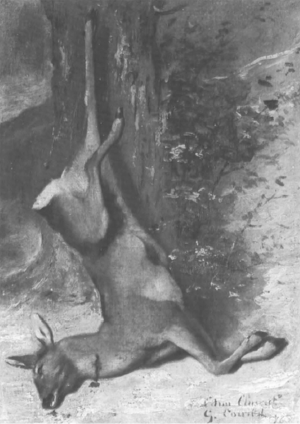 fig. 7
Gustave Courbet, Dead roe deer, 1876, Paris, Musée des Beaux-Arts de la Ville de Paris In this sense, the painting manifests a peculiar paradox. The event depicted is the bloodiest part of the hunt, and yet the prey's suffering is not shown. In the Salon piece, a small pool of blood is visible on the ground where the hounds are sniffing, but in Hanging roe deer, all references to cutting and disembowelling have been avoided: the deer's sliced-open belly is turned away from the viewer. Yet there had long been a convention in painting which did not eschew blood and gore. Courbet would have had access to Rembrandt's Disembowelled ox in the Louvre, which shows the staked-open animal in all its fleshy glory. In Courbet's painting, however, we are only shown the attractive side of the animal which - there is no other way of putting it - has been painted with a great deal of affection. The tragic look in the empty blue eyes is underlined by the animal's powerless pose. In his letters the artist spoke respectfully of the beauty and vitality of deer, and by rendering the creature so discretely he appears to have wanted to save it from any further humiliation. It would seem that Courbet, who, on the whole, never spared his audience, has | |
[pagina 93]
| |
here recoiled at a certain point, probably precisely because he did know the realities of the hunt. He has here applied the principle of decorum used in history painting to guarantee the integrity of the human figures, even if the respect he shows was prompted by his reverence for nature rather than the painting tradition. Courbet's friend and great admirer, the critic Champfleury, author of the manifesto Le réalisme, however, had a different view. He found that his hero, the painter of large-scale, democratic, modern history paintings that rejected beauty - The stonebreakers (1849) and A burial at Ornans (1850) - had abandoned his true calling for the sake of commercial success. The writer saw the Hanging roe deer at an exhibition on the Boulevard des Italiens and wrote: ‘The roe deer, having been so successful at the Salon [he is here referring to The quarry and the private exhibition on the Boulevard des Italiens, has won over the timid souls who, seeing nothing but a dead animal in a landscape, and relieved no longer to be confronted with frightening human figures, seek to propel the artist towards the second rate.’Ga naar voetnoot28 This is a fascinating piece of criticism, firstly because it comes from a friend who was gradually becoming alienated from Courbet, and secondly because it contains a germ of truth. Courbet did indeed manage to sell the Hanging roe deer at this exhibition for the considerable sum of 2,500 francs.Ga naar voetnoot29 His Battle of the stags was almost sold at about this time to the Administration des Beaux-Arts, and he was nominated as a candidate for the Légion d'honneur. Appearances therefore certainly suggest that Courbet was being coopted by the establishment of the Second Empire, whereas it had been precisely their rejection of this regime that had tied him to Champfleury. By choosing to paint animals, Courbet had abandoned his role as a militant painter, Champfleury argued, because although ‘a great artist [is] capable of rendering worthwhile all that is touched by his brush,’ this did not mean that all subjects were equally important: ‘man is of greater interest than an animal, and artists who focus exclusively on the representation of fowl and livestock are artists of an inferior kind.’Ga naar voetnoot30 Ironically, Champfleury, who clearly had no time for l'art pour l'art, has here re-introduced the ancient hierarchy of genres, one of the mainstays of the academic theory he utterly detested. He also added a social and political dimension to his criticism, commenting derisively that ‘rich landowners should simply invite the artist to decorate the extensive halls of their castles with hunting scenes.’Ga naar voetnoot31
Champfleury desired a role for artists in society and refused them a personal art. The private significance of these paintings for Courbet becomes apparent in the later variation (fig. 7) painted in Switzerland, where he was exiled following the downfall of the Paris Commune. Courbet dedicated the painting to his fellow exile, General Gustave-Paul Cluseret. Human suffering and the suffering of the animal seem here to have been set on a par. Courbet wrote of his friend and compatriot, the poet Max Buchon - who had been forced to flee to Switzerland much earlier, after the coup d'état of 1851 - that ‘he was hunted like a wild beast.’Ga naar voetnoot32 Courbet also painted himself wounded at the foot of a tree in L'homme blessé (Paris, Musée d'Orsay) - a romantic self portrait as a ‘gasping, dying man.’Ga naar voetnoot33 Having manoeuvred themselves into the position of victimes de la société, Courbet and his fellow republicans had identified their lot with that of wild prey. |
|

